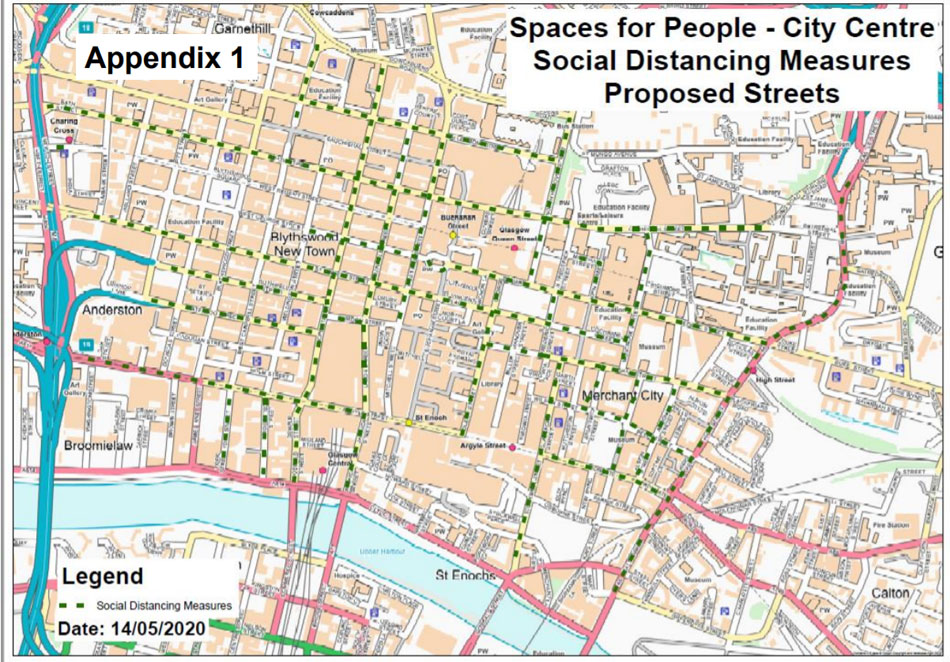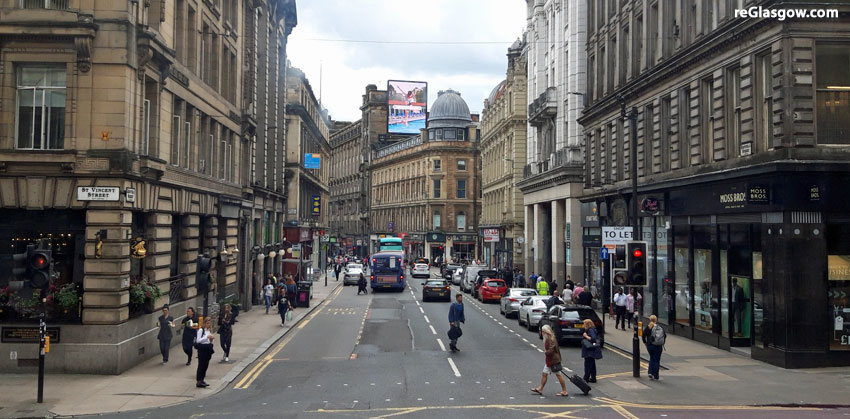GLASGOW City Council is planning to give 25 kilometres of city centre road space to pedestrians and cyclists as part of pandemic physical distancing measures.
The proposal affects nearly every city centre street and is one of a number outlined in a report updating councillors.
The document states: “For the city centre, a street-by-street approach will be undertaken with temporary measures introduced to allow priority to be given to pedestrian space around our transport hubs, core shopping streets and any identified pedestrian pinch points.
“The area being considered will result in 25 kilometres of kerbside road lanes in the City Centre being reallocated for walking and cycling.
“In most cases, widening of the space for pedestrians will necessitate the removal of on-street parking.”
Other measures being looked at for the City Centre include:
— Increasing the green man time at junctions or reducing the traffic light cycle times to aid pedestrians.
— Changing pedestrian crossings to be automatically set at the green man and requiring to be activated by vehicles, rather than on pedestrian demand.
— Selective road closures where feasible.
— Making narrow footways with limited space one-way, with perhaps additional crossing points.
— Identifying how to encourage and facilitate responsible queuing at bus stops.
— Identifying and targeting the key walking routes from main public transport interchanges.
— Identifying and targeting potential cycle routes through the city centre linking to strategic routes.
— Discuss with Transport Scotland or Department for Transport, the possibility of a dispensation to trial e-scooters in the city centre.
— Investigating the potential to increase the number of bikes and electric bikes available in the hire scheme.
— Installing additional on-street cycle parking where space is available.
Temporary re-allocation of road space for physical distancing outside shops — mainly involving the removal of kerbside parking — is also under consideration for Partick, Shawlands, Maryhill and Dennistoun.
The report adds: “Where possible, delineation of road space converted to walking and cycling space will be done as unobtrusively as possible using signing and lining.
“However, in most cases physical barriers will be required to provide an element of safety and to ensure motorists do not enter an area set aside for pedestrians and cyclists.”
On the wider road network, officials are looking at accelerating and extending existing developed cycle schemes, including:
— Great Western Road: Duntreath Avenue to Lincoln Avenue
— South City Way including bus gate on Gorbals Street.
— London Road: Kirkpatrick Street to Braidfauld Street.
— North East Active Travel Route to Stobhill Hospital.
— Extend South City Way to Battlefield linking the New Victoria Infirmary Hospital.
— Hawthorn Street/Bilsland Drive.
The council has already secured £3.5million towards physical distancing projects and is bidding for further money.
The report explains: “As we move towards a relaxation of the lockdown, it is important that we consider what measures we need to take as a council to manage our road network differently to facilitate physical distancing, help prevent a second wave of Covid-19 and allow the city economy to start to recover.
“It is anticipated that physical distancing will be needed for a significant period of time post lockdown and that there may be reluctance from the public to use public transport.
“We will therefore consider short-term measures to support physical distancing to help combat Covid-19 infection and a medium to longer term approach to enable sustainable travel choices.”
Officials further state: “Every effort will be made to ensure the needs of disabled people are fully considered in the planning and delivery of measures and the project team will endeavour to ensure that the measures reflect the considerations identified in the recent briefing paper issued by the Mobility and Access Committee for Scotland (MACS).
“It is also important that we build in lessons learned from early pilot schemes, such as those already delivered on Clyde Street and Dumbreck Road, into future schemes, and be willing to amend implemented schemes should the need arise.”



